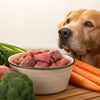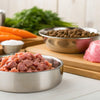Is Raw Dog Food Dangerous to Humans? Understanding the Risks and Realities
- Houndsy
Table of Contents
- Introduction
- Understanding Raw Dog Food
- The Risks: Bacterial Contamination
- Safe Practices for Raw Feeding
- Potential Health Consequences for Humans
- Nutritional Adequacy of Raw Dog Food
- The Houndsy Solution: Convenience Meets Style
- Conclusion
Introduction
As we embrace the love for our furry companions, nutritional choices often become a hot topic among pet owners. Did you know that feeding raw dog food, although increasingly popular, carries significant health risks not just for our pets but also for us? In fact, the Centers for Disease Control and Prevention (CDC) estimates that approximately 48 million Americans suffer from foodborne illness each year, with a notable number stemming from contact with raw meat. In this blog post, we will delve into the potentially dangerous implications of raw dog food on human health and explore safe practices for those who choose this feeding method.
By the end of this post, we aim to provide clarity on whether raw dog food can be dangerous to you, the human members of your household, and the safety measures that need to be taken for those who may still lean towards raw feeding. We'll cover various aspects, including the scientific insights on bacterial risks, how these pathogens can affect human health, and the protocols that should be followed to mitigate risks. If you're contemplating raw dog feeding or are already on board, we encourage you to reflect on your practices and consider how you can keep both you and your pet safe.
Understanding Raw Dog Food
In recent years, the trend of feeding dogs raw or "biologically appropriate" diets has surged. The premise behind feeding raw diets is appealing: supporters argue that mimicking a wild canine's natural diet offers health benefits such as improved skin and coat, better digestion, and increased energy levels. However, alongside these potential benefits, there are significant concerns regarding the safety and nutritional adequacy of raw dog food.
Types of Raw Diets
Raw dog food typically includes uncooked meat, organs, and bones. It can be purchased as commercial products or prepared at home. The common types of raw dog food include:
- Commercial Raw Diets: These are pre-packaged and can come frozen, freeze-dried, or dehydrated.
- Homemade Raw Diets: Often prepared by pet owners using various ingredients selected based on perceived nutritional needs.
Regardless of the source, it is crucial to understand that raw diets are not without risks—which brings us to a vital point in our discussion: the presence of pathogens in raw meat and their potential to affect human health.
The Risks: Bacterial Contamination
Feeding raw dog food poses significant health risks due to bacterial contamination. Numerous studies, including an influential one by the FDA, have established links between raw pet food and serious pathogens such as Salmonella and Listeria monocytogenes.
Common Pathogens Found in Raw Dog Food
-
Salmonella: This bacteria can lead to severe food poisoning. The FDA study found that about 7% of raw dog food samples tested positive for Salmonella. The Centers for Disease Control and Prevention (CDC) estimates that thousands of Americans contract Salmonella each year through contaminated food sources, and raw dog food poses a similar threat when pet owners handle the food.
-
Listeria monocytogenes: This pathogen is particularly dangerous for vulnerable populations, including pregnant women and those with compromised immune systems. In the same FDA study, approximately 16% of raw dog food samples were contaminated with Listeria. The risk of severe illness from Listeria can be serious as it can lead to hospitalization and even death.
-
Campylobacter: Another significant pathogen often associated with poultry, Campylobacter can cause gastrointestinal illness in humans. In raw feed preparation, cross-contamination can easily occur between raw meat and food intended for human consumption.
-
E. coli: Some strains of E. coli can cause severe illness in humans. Raw meat, particularly beef, is a common source. Handling raw dog food and coming into contact with an infected pet can lead to transmission.
How Do Humans Get Infected?
The primary methods of infection include:
- Direct Contact: Handling raw dog food and not properly washing hands afterward can result in transfer of bacteria.
- Contact with Pets: If a pet has consumed raw food and later licks a person, bacteria can be transmitted through saliva.
- Cross-Contamination: Surfaces such as countertops, utensils, and feeding bowls can harbor harmful bacteria if not properly cleaned after contact with raw food.
Safe Practices for Raw Feeding
Despite the risks, many pet owners prefer raw feeding due to its apparent benefits. If you choose to feed raw dog food, it's essential to adopt stringent hygiene practices. Here are some recommended safety measures:
1. Cleanliness is Key
- Thorough Handwashing: Always wash hands with soap and water for at least 20 seconds after handling raw food. This includes handling the packaging, utensils, and any surfaces that may have come in contact with the food.
2. Separate Preparation Areas
- Designated Utensils and Surfaces: Use separate cutting boards and utensils for raw pet food to prevent cross-contamination with human food. Avoid using shared kitchen surfaces wherever possible.
3. Safe Food Handling
- Store Raw Food Properly: Keep raw meat in the freezer until it’s time to prepare it. When thawing, use the refrigerator or microwave instead of room temperature to prevent bacterial growth.
4. Feed and Store Safely
- Dispose of Leftovers: If your pet doesn’t finish their raw meal, store the leftovers safely in a sealed container in the refrigerator and dispose of any uneaten portion within 4 hours.
5. Avoid Physical Contact
- No Face Licking: Refrain from allowing your pet to lick your face, particularly after they have consumed raw food. This simple practice can significantly reduce your risk of contamination.
6. Educate Yourself
- Stay Informed: Regularly consult with your veterinarian about the potential risks and benefits of a raw diet. They can provide sound advice and recommendations based on current research and your pet's health needs.
Potential Health Consequences for Humans
The risk to human health from raw dog food is sobering. According to The CDC's data, foodborne illnesses lead to severe consequences; one estimate suggests that around 128,000 Americans are hospitalized each year as a result of infections from foodborne pathogens. With vulnerable populations, including infants, the elderly, and pregnant women, the stakes are even higher. Salmonella can lead to severe gastrointestinal illness, while Listeria can cause listeriosis, which can be particularly dire for pregnant women and their unborn children. So, while raw diets have their proponents, it is crucial to weigh these risks thoroughly against the perceived benefits.
Nutritional Adequacy of Raw Dog Food
Beyond bacterial contamination, nutritional concerns arise with raw diets. A raw dog food diet can often lack essential nutrients, leading to deficiencies that can severely impact a pet's health:
Essential Nutrients
- Despite the high protein levels in raw diets, they can often fall short of vitamins and minerals necessary for complete health.
Balanced Diets
- The Association of American Feed Control Officials (AAFCO) regulates pet foods to ensure they are balanced and complete; however, many raw foods lack this verification. This deficiency can lead to health issues over time, raising significant questions about the long-term benefits of raw feeding.
The Houndsy Solution: Convenience Meets Style
At Houndsy, we understand the importance of maintaining a safe, enjoyable feeding experience for both pets and their owners. Our flagship product, the Houndsy Kibble Dispenser, embodies our commitment to blending functional design with daily pet care. With features that prevent accidental dispensing and allow for easy portion control, the Houndsy Kibble Dispenser creates a clutter-free, beautiful feeding ritual. We encourage you to explore the Houndsy Kibble Dispenser and see how our innovative approach can simplify your dog-feeding routine while maintaining a stylish home.
Conclusion
The debate around raw dog food is ongoing, and as conscientious pet owners, it is crucial to prioritize safety and nutrition in our pets' feeding routines. The dangers posed by raw diets, particularly concerning the health of humans who handle the food, cannot be overstated. From bacterial infections to nutritional inadequacies, there are many factors to weigh when deciding on a raw diet for your beloved pets.
While some may choose to continue feeding raw, taking the right precautions is essential to ensure the well-being of both the pet and the family. If you're considering raw feeding or are already committed to it, remember to prioritize the health of your household by implementing strict hygiene practices, consulting your veterinarian, and exploring nutritious alternatives that may reduce risks while keeping your pets healthy and happy.
FAQ
Is raw dog food dangerous to humans?
Yes, raw dog food can pose significant health risks to humans, primarily through bacterial contamination such as Salmonella and Listeria. Proper handling and hygiene can mitigate some of these risks.
What are safe practices for handling raw dog food?
Always wash your hands after handling raw food, use separate utensils and surfaces for pet food preparation, and store raw food properly. Do not allow pets to lick your face after eating raw food.
What are the health risks associated with raw dog food?
Health risks include potential infections from pathogens like Salmonella, Listeria, and E. coli, which can cause gastrointestinal illnesses in humans and pets alike.
Can raw diets meet my pet’s nutritional needs?
While raw diets often provide high protein, they can lack complete nutrition and essential vitamins and minerals necessary for overall health.
Are there safer alternatives to feeding raw?
Yes, we recommend consulting with your veterinarian about commercially prepared pet foods that are cooked and meet nutritional standards, such as those made available through Houndsy that prioritize safety and quality without sacrificing health.












